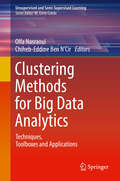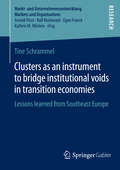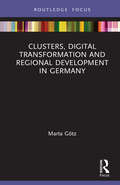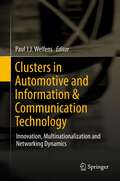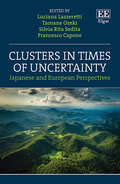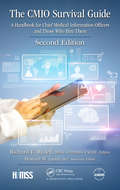- Table View
- List View
Clustering Dynamics and the Location of High-Tech-Firms (Contributions to Economics)
by Mario A. MaggioniAcross a line drawn from New York to Los Angeles, the level of cconomi
Clustering Methods for Big Data Analytics: Techniques, Toolboxes and Applications (Unsupervised and Semi-Supervised Learning)
by Olfa Nasraoui Chiheb-Eddine Ben N'CirThis book highlights the state of the art and recent advances in Big Data clustering methods and their innovative applications in contemporary AI-driven systems. The book chapters discuss Deep Learning for Clustering, Blockchain data clustering, Cybersecurity applications such as insider threat detection, scalable distributed clustering methods for massive volumes of data; clustering Big Data Streams such as streams generated by the confluence of Internet of Things, digital and mobile health, human-robot interaction, and social networks; Spark-based Big Data clustering using Particle Swarm Optimization; and Tensor-based clustering for Web graphs, sensor streams, and social networks. The chapters in the book include a balanced coverage of big data clustering theory, methods, tools, frameworks, applications, representation, visualization, and clustering validation.
Clustermanagement: Wie Cluster die Innovation und die Wettbewerbsfähigkeit unterstützen
by Eduard HauserDas Buch zeigt die Ausgangslage für den Aufbau von Clustern in der Schweiz und stellt anhand einiger Beispiele aus unterschiedlichen Branchen dar, wie Cluster erfolgreich sein können. Es werden internationale Ansätze zur Stärkung von Netzwerken dargestellt, Checklisten liefern Hinweise für Praktiker, die Cluster lancieren wollen.
Clustermanagement in der Praxis: Geschäftsmodelle
by Gerd Meier zu Köcker Thomas WolfIn der regionalen Wirtschaftsentwicklung nehmen Clusterinitiativen eine große Bedeutung ein, gerade wenn es um die Steigerung von Innovationskraft bei kleineren und mittleren Unternehmen geht. Doch wie lassen sich Clusterinitiativen sinnvoll als Instrument in die Regionalentwicklung einbetten und wie kann gutes Clustermanagement als zentrale Schlüsselfunktion aussehen, damit die Netzwerke ihr volles Potenzial entfalten können?In den letzten Jahren gab es vermehrt gelungene Beispiele dafür, wie Clusterinitiativen Mehrwerte im Sinne ihrer Akteure generieren können. Dieses Buch stellt erfolgreiche Geschäftsmodelle von Clusterinitiativen vor und gibt einen Überblick über die Chancen und Herausforderungen im täglichen Geschäft. Es bietet eine praxisorientierte Hilfestellung und viele Best-Practice-Beispiele speziell für Clustermanager, aber auch für Wirtschaftsförderungen, Kommunen, Verwaltung, Unternehmen, Wissenschaft, Verbände und Vereine.
Clustermanagement in der Praxis: Transformation
by Gerd Meier zu Köcker Thomas WolfIn der regionalen Wirtschaftsentwicklung nehmen Clusterinitiativen eine große Bedeutung ein, gerade wenn es um die Steigerung von Innovationskraft bei kleineren und mittleren Unternehmen geht. Doch wie lassen sich Clusterinitiativen sinnvoll als Instrument in die Regionalentwicklung einbetten und wie kann gutes Clustermanagement als zentrale Schlüsselfunktion aussehen, damit die Netzwerke ihr volles Potenzial entfalten können? In den letzten Jahren gab es vermehrt gelungene Beispiele dafür, wie Clusterinitiativen Mehrwerte im Sinne ihrer Akteure generieren können. Dieses Buch stellt erfolgreiche Transformationen von Clusterinitiativen vor und gibt einen Überblick über die Chancen und Herausforderungen im täglichen Geschäft. Es bietet eine praxisorientierte Hilfestellung und viele Best-Practice-Beispiele speziell für Clustermanager, aber auch für Wirtschaftsförderungen, Kommunen, Verwaltung, Unternehmen, Wissenschaft, Verbände und Vereine.
Clusters and Competitive Advantage: The Turkish Experience
by Ö. ÖzThis book aims to clarify the link between geographic clustering and international competitiveness in light of the Turkish experience, a subject that is high on the agendas of researchers as well as policy makers and strategic planners. The key findings of the study are discussed with respect to the recent debates on clusters to provide a full account of what the Turkish experience, when looked from the viewpoint of the strategic management discipline, offers to further intellectual thinking on clusters.
Clusters and Sustainable Regional Development: A Meta-Organisational Approach (Routledge Advances in Regional Economics, Science and Policy)
by Evgeniya Lupova-Henry Nicola Francesco DottiClusters and Sustainable Regional Development conceptualises the role of organised clusters in the transition towards sustainability. It introduces a novel perspective on these clusters, viewing them as deliberate collective actors within their environments that can become the driving force for transformation in their regions or nations. The book draws upon the meta-organisational perspective in cluster studies, in contrast to traditional approaches. This view suggests that clusters are not merely territories or geographical areas, but organised entities. As such, they are defined as territorially anchored groups of independent organisations engaging in joint decision-making, pursuing system-level goals and capable of purposive collective action. This text introduces a new set of ideas and questions at the intersection of economic geography, regional and cluster studies, organisation and management, policy and governance research. It will appeal to researchers from these diverse fields seeking to further develop the meta-organisational view of clusters as well as conceptualise their role in sustainability transitions. This book will also be a useful guide for policymakers who have an interest in the dynamics of economic development and the transition towards sustainability.
Clusters and Sustainable Regional Development: A Meta-Organisational Approach (Routledge Advances in Regional Economics, Science and Policy)
by Evgeniya Lupova-Henry Nicola Francesco DottiClusters and Sustainable Regional Development conceptualises the role of organised clusters in the transition towards sustainability. It introduces a novel perspective on these clusters, viewing them as deliberate collective actors within their environments that can become the driving force for transformation in their regions or nations. The book draws upon the meta-organisational perspective in cluster studies, in contrast to traditional approaches. This view suggests that clusters are not merely territories or geographical areas, but organised entities. As such, they are defined as territorially anchored groups of independent organisations engaging in joint decision-making, pursuing system-level goals and capable of purposive collective action. This text introduces a new set of ideas and questions at the intersection of economic geography, regional and cluster studies, organisation and management, policy and governance research. It will appeal to researchers from these diverse fields seeking to further develop the meta-organisational view of clusters as well as conceptualise their role in sustainability transitions. This book will also be a useful guide for policymakers who have an interest in the dynamics of economic development and the transition towards sustainability.
Clusters as an instrument to bridge institutional voids in transition economies: Lessons learned from Southeast Europe (Markt- und Unternehmensentwicklung Markets and Organisations)
by Tine SchrammelTransition economies, such as the countries in Southeast Europe, face an expeditious institutional transition from a centrally planned to a market economy. The state withdraws from its monitoring function, which results in institutional voids that affect the economy in general and small and medium sized enterprises (SMEs) in specific. With a qualitative case study approach Tine Schrammel develops a scheme to detect institutional voids as one source of competitive disadvantages of SMEs in transition economies. In a second step she demonstrates that specific cluster services bridge institutional voids and improve the competitive position of SMEs in environments of institutional voids. The findings add to the understanding of institutional voids and to the role of clusters in transition economies.
Clusters, Digital Transformation and Regional Development in Germany (Routledge Focus on Business and Management)
by Marta GötzThe information age is reshaping current socio-economic structures and processes and this book touches upon the nature of clusters in the fourth industrial revolution (Industry 4.0; I4.0). It focuses on the spatial perspective of digital business transformation and explores in natural context the interrelations between cluster and I4.0. It investigates the role of knowledge, business relations and policy in making cluster relevant for Industry 4.0 and uses the case study method and literature review to develop a conceptual framework outlining the functioning of Industry 4.0 cluster. This book argues that locally embedded knowledge accompanied by strong presence of industry and assisted by proper governance management facilitate the implementation of I4.0. The idiosyncrasies of Industry 4.0 impact also the functioning of cluster as they require more interdisciplinary integrative approach with the provision of industrial commons and development of related varieties. Natural processes of stretching of the cluster cannot be prevented, but should be harnessed for upgrading the core competences of cluster. This book can enrich existing literature on economic geography and regional studies by discussing the spatial aspects of digital transformation. It shows the cluster transformation as induced by the digital transformation, and will be of interest to researchers, academics, policymakers, and students who explore the regional and local development, competitiveness, or managerial aspects of fourth industrial revolution.
Clusters, Digital Transformation and Regional Development in Germany (Routledge Focus on Business and Management)
by Marta GötzThe information age is reshaping current socio-economic structures and processes and this book touches upon the nature of clusters in the fourth industrial revolution (Industry 4.0; I4.0). It focuses on the spatial perspective of digital business transformation and explores in natural context the interrelations between cluster and I4.0. It investigates the role of knowledge, business relations and policy in making cluster relevant for Industry 4.0 and uses the case study method and literature review to develop a conceptual framework outlining the functioning of Industry 4.0 cluster. This book argues that locally embedded knowledge accompanied by strong presence of industry and assisted by proper governance management facilitate the implementation of I4.0. The idiosyncrasies of Industry 4.0 impact also the functioning of cluster as they require more interdisciplinary integrative approach with the provision of industrial commons and development of related varieties. Natural processes of stretching of the cluster cannot be prevented, but should be harnessed for upgrading the core competences of cluster. This book can enrich existing literature on economic geography and regional studies by discussing the spatial aspects of digital transformation. It shows the cluster transformation as induced by the digital transformation, and will be of interest to researchers, academics, policymakers, and students who explore the regional and local development, competitiveness, or managerial aspects of fourth industrial revolution.
Clusters in Automotive and Information & Communication Technology: Innovation, Multinationalization and Networking Dynamics
by Paul J.J. WelfensInformation & communication technology (ICT) and the automotive sector are two of the most important industries in the EU and the US. The EU’s eastern expansion and economic globalization have reinforced competition on the one hand; on the other hand the importance of outsourcing and off-shoring has increased. Against this background the intensification of innovation dynamics becomes crucial – and with them the role of regional innovation clusters. The analysis examines seven regions and six EU countries. The focus is on cluster and network dynamics in both industries, as regional ICT clusters are playing an increasingly central role in many European regions. Specialization and structural change in the automotive sector are highlighted, and new strategic approaches for multinational companies and changes in policy options are identified.
Clusters in Times of Uncertainty: Japanese and European Perspectives
Delivering a global perspective, Clusters in Times of Uncertainty follows the transformation of clusters in a world defined by digital collaboration and green economies. In this innovative book, contributors deconstruct and compare examples from Japan and Europe to explore the opportunities and challenges that clusters present in our modern age.Experts from economics and regional studies highlight the potential of cluster ecosystems for sustainable growth and societal well-being. A diverse range of rigorous analyses are implemented to address pressing issues such as environmental concerns, circular economy practices, social inclusion, and digital technologies. Chapters feature international case studies ranging from the Sapporo Valley cluster in Japan, to Polish National Key Clusters, to collaborations between Asia, Europe, and Latin America. Overarching phenomena such as B Corps are examined, as well as the inclusion of arts and crafts to promote sustainable practices and to enrich the cultural fabric and overall competitiveness of creative clusters.Clusters in Times of Uncertainty is a valuable resource for understanding how clusters can foster resilient and sustainable economies. It provides creative insights and practical implications for academics studying economics of innovation, industrial and regional economics, and regional studies, as well as for policymakers and practitioners involved in regional development and economic growth.
Clusters of Creativity: Enduring Lessons on Innovation and Entrepreneurship from Silicon Valley and Europe's Silicon Fen
by Rob Koepp"An innovative book for an innovative topic." Charles Hampden-Turner Like the subject matter it covers, Clusters of Creativity is innovative and original. It breaks with popular interpretations of Silicon Valley and similar regions, which range from the hyperbolically laudatory to the contemptuously dismissive, and takes a critical, objective look at the lessons that these locations provide about innovation and entrepreneurship. Readable, yet rigorous in its analyses, the book provides a practical and balanced set of perspectives on how the powers of business creativity are fostered and sustained. It focuses not so much on the generations of high technologies but on the motivations and strategies of business leaders who turn revolutionary innovations into commercial realities. Clusters of Creativity demystifies the many enigmas that surround two leading capitals of the modern global economy, providing insights on managing innovation and entrepreneurship that are both eye-opening and broadly applicable to all organizations and industries. Clusters of Creativity will challenge assumptions, dispel myths, enlighten, inspire, and generally provoke thought. In an age where technology and hyperbole frequently go hand-in-hand, the book's well-founded insights are all the more refreshing and important.
Clusters of Innovation in the Age of Disruption
This book is about innovation ecosystems, Clusters of Innovation (COI) and the Global Networks of Clusters of Innovation (GNCOI) they naturally form. What is innovation and why is it important to us? Innovation is nothing less than the ability for constructive response and adaptation to change. The cause and catalyst for that change is frequently identified as technology and its unceasing pressure to improve on existing solutions and address unmet needs. The last decade has painfully demonstrated that exogenous environmental shocks are also sources of change that call for innovative responses, ranging from the obvious challenges such as global warming and Covid-19 to the more subtle social and political perturbations of our time.Entrepreneurs, in collaboration with venture investors and major corporations can create a flywheel of constructive engagement, a cluster of Innovation, that helps build the resiliency of our communities to adsorb and rebound from these shocks. The process is enhanced when actively supported by government, universities, and other elements of the ecosystem. This book provides the tools for understanding this value creation process and the means to enhance it, in both emerging and mature innovation ecosystems.This book provides a framework for understanding innovation in mature and emerging innovation ecosystems to a wide swath of professionals and academics, from senior executives of major corporations, government leaders, public policy makers, and consultants, to academics, researchers, and educators.
The CME Group Risk Management Handbook: Products and Applications (Wiley Finance #410)
by CME Group John W. Labuszewski John E. Nyhoff Richard Co Paul E. PetersonPraise for The CME Group Risk Management Handbook "Wow! The CME Group Risk Management Handbook is a 'ten strike' and long overdue. A must-read and reference for the risk management industry!" —Jack Sandner, retired chairman of CME Group, member of the Executive Committee "This is a powerful book for its integration of futures and options markets with an understanding of the whole economy. It is an eye-opener to see how central these markets are to our economic lives." —Robert J. Shiller, Okun Professor of Economics, Yale University; Chief Economist, MacroMarkets LLC "Risk management is essential to successful investing, and The CME Group Risk Management Handbook provides the essentials for understanding risk management. In the wake of the financial turmoil of the last few years, managing risk should be part of any investment program. Among the key elements of risk management are stock index, bond, currency, and commodity futures as well as a growing number of futures, options, swaps, and other financial instruments built on indices tracking housing prices, weather conditions, and the economy. The CME Group Risk Management Handbook offers a comprehensive guide for using all of these to better manage financial risks." —David M. Blitzer, PhD, Managing Director and Chairman of the Index Committee, S&P Indices "Dare we ignore the advice of a financial institution, the largest of its kind in the world, that navigated the recent financial crisis without the aid of a single TARP dollar or access to the Fed's cheap loans? For CME Group, risk management has meant risk minimization as it enters its 151st year of life and its 85th year of central counterparty clearing without a single trading debt unpaid. It has been, and continues to be, a leader by example." —Philip McBride Johnson, former CFTC chairman "For the first time, a comprehensive handbook outlining the futures market in today's world is available. The CME Group Risk Management Handbook covers futures basics for the novice trader, while the veterans will benefit from an in-depth look at options and hedging. This handbook is a necessity for any professional, investor, or other market participant seeking to manage risk in the perpetually changing futures market." —H. Jack Bouroudjian, CEO, Index Futures Group
The CME Group Risk Management Handbook: Products and Applications (Wiley Finance #410)
by CME Group John W. Labuszewski John E. Nyhoff Richard Co Paul E. PetersonPraise for The CME Group Risk Management Handbook "Wow! The CME Group Risk Management Handbook is a 'ten strike' and long overdue. A must-read and reference for the risk management industry!" —Jack Sandner, retired chairman of CME Group, member of the Executive Committee "This is a powerful book for its integration of futures and options markets with an understanding of the whole economy. It is an eye-opener to see how central these markets are to our economic lives." —Robert J. Shiller, Okun Professor of Economics, Yale University; Chief Economist, MacroMarkets LLC "Risk management is essential to successful investing, and The CME Group Risk Management Handbook provides the essentials for understanding risk management. In the wake of the financial turmoil of the last few years, managing risk should be part of any investment program. Among the key elements of risk management are stock index, bond, currency, and commodity futures as well as a growing number of futures, options, swaps, and other financial instruments built on indices tracking housing prices, weather conditions, and the economy. The CME Group Risk Management Handbook offers a comprehensive guide for using all of these to better manage financial risks." —David M. Blitzer, PhD, Managing Director and Chairman of the Index Committee, S&P Indices "Dare we ignore the advice of a financial institution, the largest of its kind in the world, that navigated the recent financial crisis without the aid of a single TARP dollar or access to the Fed's cheap loans? For CME Group, risk management has meant risk minimization as it enters its 151st year of life and its 85th year of central counterparty clearing without a single trading debt unpaid. It has been, and continues to be, a leader by example." —Philip McBride Johnson, former CFTC chairman "For the first time, a comprehensive handbook outlining the futures market in today's world is available. The CME Group Risk Management Handbook covers futures basics for the novice trader, while the veterans will benefit from an in-depth look at options and hedging. This handbook is a necessity for any professional, investor, or other market participant seeking to manage risk in the perpetually changing futures market." —H. Jack Bouroudjian, CEO, Index Futures Group
The CMIO Survival Guide: A Handbook for Chief Medical Information Officers and Those Who Hire Them, Second Edition (HIMSS Book Series)
by Richard L. Rydell, MBA, FACHE, LFHIMSS, Editor Howard M. Landa, MD, Associate EditorThe CMIO Survival Guide is the handbook for the new Chief Medical Information Officer, as well as for those recruiting or planning to recruit a CMIO. This quick reference is organized by real-world topics that CMIOs need to know, as well as the criteria that the CIO, CMO or CEO should consider in identifying excellence in a CMIO candidate. It is written by pioneering physicians and AMDIS faculty with a wealth of experience in medical informatics who provide guidance, advice and lessons learned for those interested in this relatively new role in healthcare. This second edition updates every chapter in the original work and adds new chapters to address the changes in healthcare delivery, the role of the physician executive, technology, medical education, small and rural hospitals.
The CMIO Survival Guide: A Handbook for Chief Medical Information Officers and Those Who Hire Them, Second Edition (HIMSS Book Series)
by Richard L. Rydell, MBA, FACHE, LFHIMSS, Editor Howard M. Landa, MD, Associate EditorThe CMIO Survival Guide is the handbook for the new Chief Medical Information Officer, as well as for those recruiting or planning to recruit a CMIO. This quick reference is organized by real-world topics that CMIOs need to know, as well as the criteria that the CIO, CMO or CEO should consider in identifying excellence in a CMIO candidate. It is written by pioneering physicians and AMDIS faculty with a wealth of experience in medical informatics who provide guidance, advice and lessons learned for those interested in this relatively new role in healthcare. This second edition updates every chapter in the original work and adds new chapters to address the changes in healthcare delivery, the role of the physician executive, technology, medical education, small and rural hospitals.
CMR: Contracts for the International Carriage of Goods by Road (Lloyd's Shipping Law Library)
by Andrew Messent David GlassNow in its fourth edition, this hallmark text provides a comprehensive, article-by-article guide to the workings of the CMR Convention, as incorporated into English Law by the Carriage of Goods by Road Act 1965. This new edition is fully up to date with all major UK case law, plus major developments in the interpretation of the Convention in the case law of other Contracting States. Furthermore, the book includes expert guidance on the amendments introduced by the additional protocol concerning the electronic consignment note of 2008. The relationship between CMR and potentially conflicting legislation, in particular the Judgments Regulation of 2001 and the Judgments Regulation (recast) of 2012, are also usefully examined. Praised as well-written and extremely accessible, Messent and Glass offer a level of expert detail and referencing that cannot be found elsewhere. This work is an invaluable reference tool that can be used by the busy legal practitioner, and by other road haulage industry professionals, in any contracting state, to solve the issues that confront them in daily practice. It is also an indispensable guide for academics and students of the international carriage of goods by road.
CMR: Contracts for the International Carriage of Goods by Road (Lloyd's Shipping Law Library)
by Andrew Messent David GlassNow in its fourth edition, this hallmark text provides a comprehensive, article-by-article guide to the workings of the CMR Convention, as incorporated into English Law by the Carriage of Goods by Road Act 1965. This new edition is fully up to date with all major UK case law, plus major developments in the interpretation of the Convention in the case law of other Contracting States. Furthermore, the book includes expert guidance on the amendments introduced by the additional protocol concerning the electronic consignment note of 2008. The relationship between CMR and potentially conflicting legislation, in particular the Judgments Regulation of 2001 and the Judgments Regulation (recast) of 2012, are also usefully examined. Praised as well-written and extremely accessible, Messent and Glass offer a level of expert detail and referencing that cannot be found elsewhere. This work is an invaluable reference tool that can be used by the busy legal practitioner, and by other road haulage industry professionals, in any contracting state, to solve the issues that confront them in daily practice. It is also an indispensable guide for academics and students of the international carriage of goods by road.
CNBC Creating Wealth: An Investor's Guide to Decoding the Market
by CNBC Brian O'ConnellDemystify investing and maximize your wealth-with guidance from the world's most trusted financial news network From CNBC, the global leader of financial news, comes the most user-friendly, approachable guide to simplifying the often confusing world of finance and investing. CNBC Creating Wealth offers a complete and comprehensive introduction to world markets and shows readers how to use the information and tools currently available for maximum wealth-building. Using the hallmark CNBC approach-demystifying complex and confusing market terminology through lucid language and instructions-this accessible primer helps readers make smarter investment choices, and stay successful and secure even in volatile markets. CNBC Creating Wealth covers: The inside story of the stock market and creating a long-term investment portfolio Strategies for the most profitable investment areas, including stocks, bonds, and mutual funds Online tools, including research, brokers, and access to data about financial markets around the world
CNC Machining Technology: Volume 3: Part Programming Techniques
by Graham T. SmithThis is the third volume of three which will give the reader an insight into the current state of CNC technology with a focus on practical applications. This volume deals with CNC programming. It has been written in conjunction with a major European supplier of controllers in order to give the reader a more consistent and in-depth understanding of the logic used to program such machines. It explains how why and where to program specific features of a part and how to build them up into complete programs. Thus, the reader will learn about the main aspects of the logical structure and compilation of a program. Finally, there is a brief review of so me of the typical controllers currently available from both universal and proprietary builders. The author draws on his extensive experience as a practitioner and teacher. The text is thoroughly practical in character and generously illustrated with diagrams and photographs.
CNC Machining Technology: Volume I: Design, Development and CIM Strategies
by Graham T. SmithThe first part of Volume I outlines the origins and development of CNC machine tools. It explains the construction of the equipment and also discusses the various elements necessary to ensure high quality of production. The second part considers how a company justifies the purchase of either cells or systems and illustrates why simulation exercises are essential prior to a full implementation. Communication protocols as well as networking topologies are examined. Finally, the important high-speed machining developments and the drive towards ultra-high precision are mentioned. Following a brief historical introduction to cutting tool development, chapters 1 and 2 of Volume II explain why CNC requires a change in cutting tool technology from conventional methods. A presentation is given of the working knowledge of cutting tools and cutting fluids which is needed to make optimal use of the productive capacity of CNC machines. Since an important consideration for any machine tool is how one can locate and restrain the workpiece in the correct orientation and with the minimum of set-up time, chapter 3 is concerned with workholding technology. Volume III deals with CNC programming. It has been written in conjunction with a major European supplier of controllers in order to give the reader a more consistent and in-depth understanding of the logic used to program such machines. It explains how why and where to program specific features of a part and how to build them up into complete programs. Thus, the reader will learn about the main aspects of the logical structure and compilation of a program. Finally, there is a brief review of so me of the typical controllers currently available from both universal and proprietary builders.
CNC Machining Technology: Volume II Cutting, Fluids and Workholding Technologies
by Graham T. SmithThis is the second volume of three designed to give an insight into the current state of CNC technology with a focus on practical applications. Following a brief historical introduction to cutting tool development, chapters 1 and 2 explain why CNC requires a change in cutting tool technology from conventional methods. A presentation is given of the working knowledge of cutting tools and cutt ing fluids which is needed to make optimal use of the productive capacity of CNC machines. Since an important consideration for any machine tool is how one can locate and restrain the workpiece in the correct orientation and with the minimum of set-u p time, chapter 3 is concerned with workholding technology. The author draws on his extensive experience as a practitioner and teacher. The text is thoroughly practical in character and generously illustrated with diagrams and photographs.

